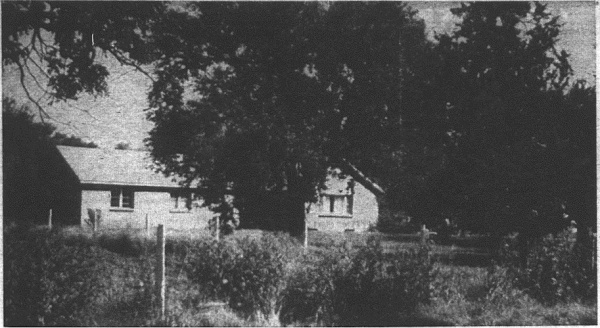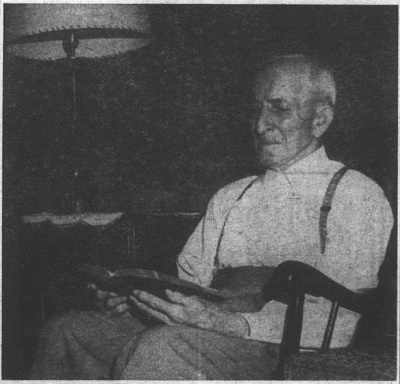If this site was useful to you, we'd be happy for a small donation. Be sure to enter "MLA donation" in the Comments box.
Plank, Solomon P. (1871-1967)
Mennonite Weekly Review obituary: 1960 Oct 27 p. 4 [article on his 90th birthday]
Birth date: 1870 Aug 8
text of obituary:

Harper Community Appropriately Named “Pleasant Valley”'
OF SPECIAL interest are the descriptive names Mennonites have given their communities and congregations.
One such appropriately named congregation is Pleasant Valley in Harper County bordering the Oklahoma line, founded in 1888. Anyone visiting the community cannot help but be impressed by the many green wheat fields, fine herds of livestock, and well built-up farms.
Other Mennonite congregations in this southern Kansas county are the Mennonite Brethren in Christ, organized in 1890, and Crystal Springs, organized in 1904.
Although known as one of the leading wheat counties in the state, Harper is also adapted to diversified farming and has become nationally famous for its prize dairy cattle.
PLEASANT Valley congregation, which began with 15 members, today has a membership of nearly 200. the first minister, Jacob Holderman, was succeeded in 1907 by R. M. Weaver — affectionately known as ”Rube” — who served the congregation for 39 years. James Detweiler is the present pastor.
Tall shade trees surround the church in which the congregation meets regularly for worship services, several miles southeast of Harper. Plans are under way to replace the present building, erected in 1915, with a new church to be located on the outskirts of town.

The 90-year-old Sol Plank, who came to Harper from Nebraska in 1916 and here raised his family. His wife died in 1922. He can still read his Bible without glasses, but “I've got to hold it up close,” says Mr. Plank
PERHAPS no better symbol of the spirit, fortitude and dedication which made the community what it is could be found than the 90-year-old Sol Plank, who came to Harper from Nebraska in 1916 and here raised his family of six children. His wife died in 1922, having been down with the flu in the great epidemic of 1918 and from which she never fully recovered.
Mr. Plank has for the past number of years made his home in Harper with his daughter Ella. A son and two sons-in-law also live at Harper. The other daughter living is Mrs. Ida Plank Yoder, writer of the Review's “Through My Kitchen Window.”
Mr. Plank's long years have been eventful and in many respects unusual. Born in Fairfield County, Ohio, Aug. 8, 1870, he left Ohio with his parents in 1883, at the age of 13. After one year at Raymond, Nebr., nine miles north of Lincoln, the family moved to the East Fairview Mennonite community near Milford in 1884.
In 1893 he went to Chappell, Nebr., where he took as his bride Mary Jane Stutsman [sic Stutzman], and together they lived simply but happily in a sodhouse. Life at Chappell was still very much in the pioneer stage, with lots of wide open spaces and much of their heating and cooking still done with the customary prairie fuel, the so-called “buffalo chips.”
From 1895-99 the family lived in Cass County, Mo., then moved back to Shickley, Nebr., transporting the belongings in a covered wagon. “It was so cold and rainy,” Mr. Plank recalls, “I put the family on the train.” In 1916 the family made its last move, coming to Harper where he has now lived for 44 years.
MR. PLANK'S 90 years have covered a period in which occurred the most far-reaching changes in the country's history. “I have seen harvesting from the sickle, cradle, binder, header and combine,” he says. Binding grain by hand was a common practice in his younger years. As for “horse power” on the farm, he remembers “we broke a team of oxen in Ohio but I never used any. I always had good horses.” At Harper the family was among the first to buy an automobile.
Particularly vivid in his memory are the years in Nebraska. The big blizzard of 1888 left an indelible impression. The storm broke in the afternoon with unexpected suddenness but the teacher fortunately did not allow the children to go home. The fine snow, driven by a fierce wind, sifted into the schoolroom even through closed shutters. The children spent the night huddled around the red-hot stove and the worst anyone suffered were frosted ears. The morning dawned cold and clear, with snow piled up to the roof at the school and on farm yards.
Indians were still a common sight around Milford, where many spent the winter trapping along the river. They lived in tepees, and at times used carcasses of frozen cattle for food.
In summing up his full and busy life, Mr. Plank says, “The Lord's been good to me. Awful good. Wonderful!”
Mennonite Weekly Review obituary: 1967 Jan 12 p. 5
text of obituary:
. . .
— Funeral services were conducted Dec. 30 at the Pleasant Valley Mennonite Church, Harper, for Solomon P. Plank, 96, who died at the Harper hospital on Dec. 28. The services were conducted by Rev. Eugene Herr, pastor, and Rev. Henry King. Mr. Plank was the father of Mrs. Ida Yoder of the Walton community, writer of the Through My Kitchen Window column in the Review.
